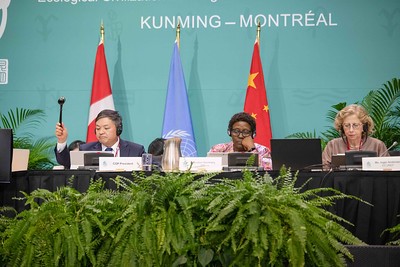
COP15: Nations reach historic biodiversity pact at Montreal UN meet
Nations commit to 30x30, or protecting 30% of land and water considered important for biodiversity, by 2030; currently, just 17% of terrestrial and 10% of marine areas are protected

Negotiators reached a historic deal at a UN biodiversity conference early on Monday that would represent the most significant effort to protect the world’s lands and oceans and provide critical financing to save biodiversity in the developing world.
The global framework comes on the day the United Nations Biodiversity Conference, or COP15, is set to end in Montreal.
China, which holds the presidency at this conference, released a new draft on Sunday that gave the sometimes contentious talks much-needed momentum. “We have in our hands a package which I think can guide us as we all work together to halt and reverse biodiversity loss and put biodiversity on the path to recovery for the benefit of all people in the world,” Chinese Environment Minister Huang Runqiu told delegates before the package was adopted to rapturous applause just before dawn. “We can be truly proud.”
Also read | COP15: India calls for new, dedicated fund for biodiversity conservation
The most significant part of the agreement is a commitment to protect 30 per cent of land and water considered important for biodiversity by 2030, known as 30×30. Currently, 17 per cent of terrestrial and 10 per cent of marine areas are protected.
Funding plan
The draft also calls for raising $200 billion by 2030 for biodiversity from a range of sources and working to phase out or reform subsidies that could provide another $500 billion for nature.
As part of the financing package, the framework calls for increasing to at least $20 billion annually by 2025 the money that goes to poor countries. That number would increase to $30 billion each year by 2030.
“Many of us wanted more things in the text and more ambition but we got an ambitious package,” Canada’s Minister of Environment and Climate Change Steven Guilbeault said. “We have 30×30. Six months ago, who would have thought we could 30×30 in Montreal? We have an agreement to halt and reverse biodiversity loss, to work on restoration, to reduce the use of pesticides. This is tremendous progress.”
Christophe Béchu, France’s minister for ecological transition who headed its delegation, called it a “historical deal”. “It’s not a small deal. It’s a deal with very precise and quantified objectives on pesticides, on reduction of loss of species, on eliminating bad subsidies,” he said. “We double until 2025 and triple 2030 the finance for biodiversity.”
Comparison with COP27 talks
The ministers and government officials from about 190 countries have mostly agreed that protecting biodiversity has to be a priority, with many comparing those efforts to COP27 climate talks that wrapped up last month in Egypt.
Climate change coupled with habitat loss, pollution and development have hammered the world’s biodiversity, with one estimate in 2019 warning that a million plant and animal species face extinction within decades, a rate of loss 1,000 times greater than expected. “Humans use about 50,000 wild species routinely, and 1 out of 5 people of the world’s 8 billion population depend on those species for food and income,” the report said.
But they struggled for nearly two weeks to agree on what that protection looks like and who will pay for it. The financing has been among the most contentious issues, with delegates from 70 African, South American and Asian countries walking out of negotiations on Wednesday. They returned several hours later.
Timeline concerns
The Wildlife Conservation Society and other environmental groups were concerned that the deal puts off until 2050 a goal of preventing the extinction of species, preserving the integrity of ecosystems and maintaining the genetic diversity within populations. They fear that the timeline is not ambitious enough.
Some advocates also wanted tougher language around subsidies that make food and fuel so cheap in many parts of the world. The document only calls for identifying subsidies by 2025 that can be reformed or phased out and working to reduce them by 2030.
With agency inputs

